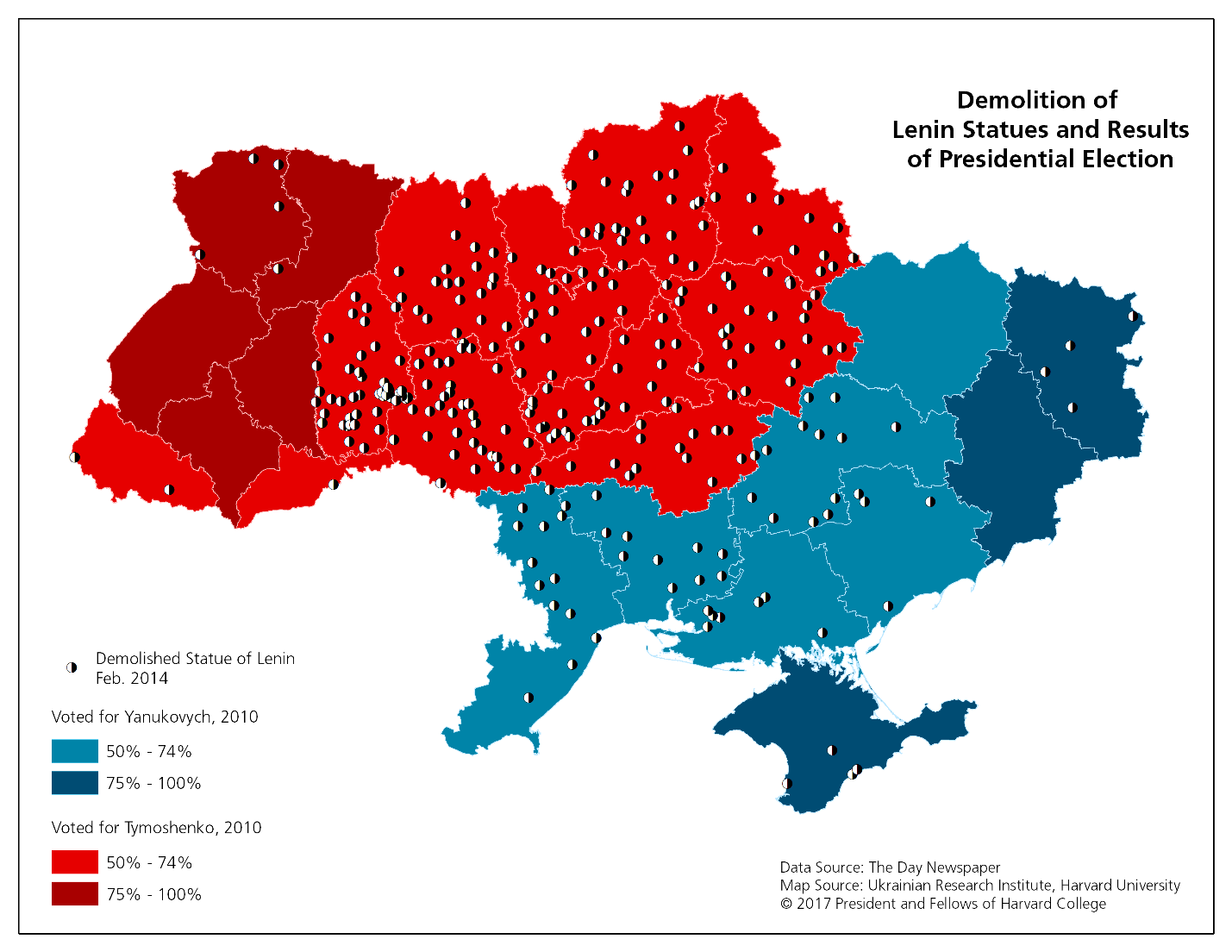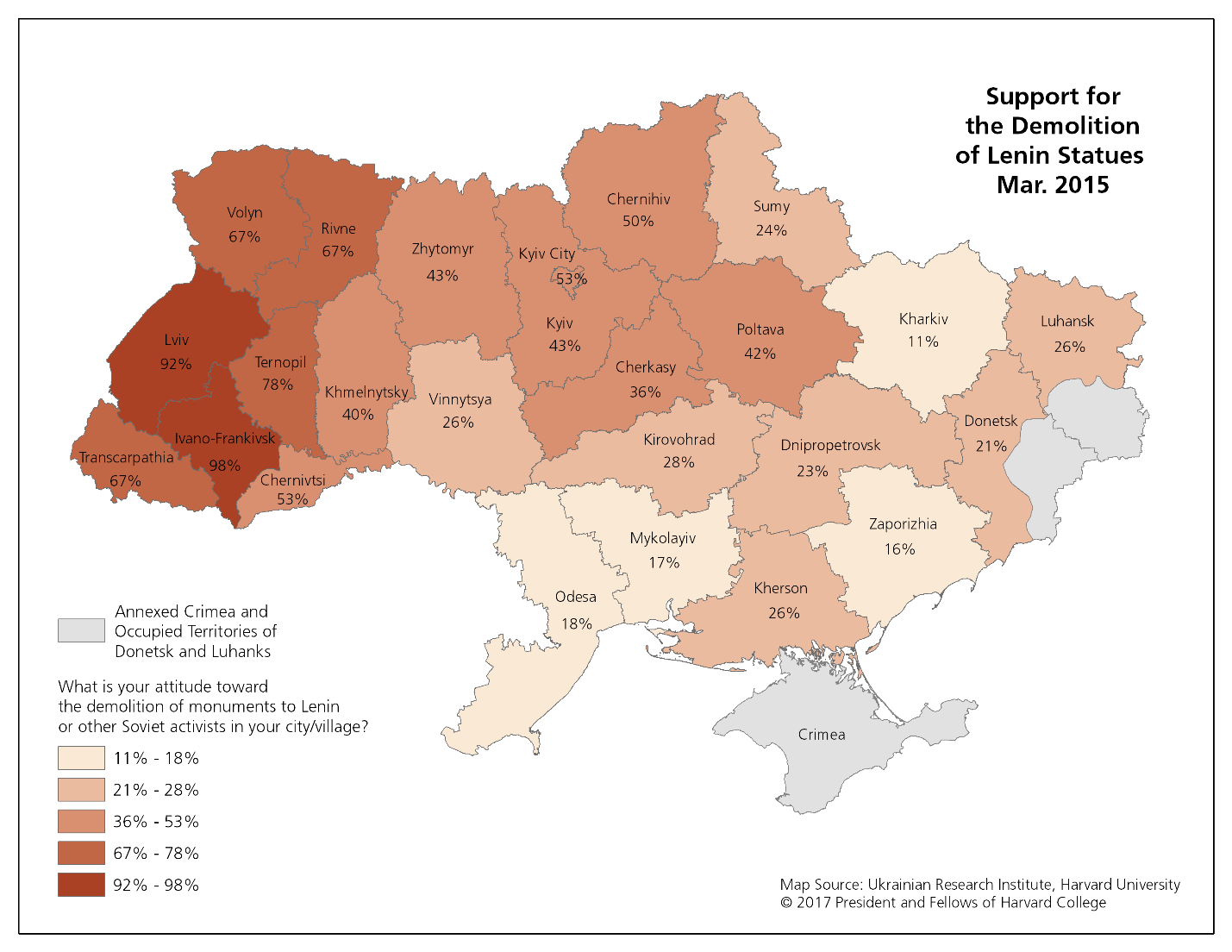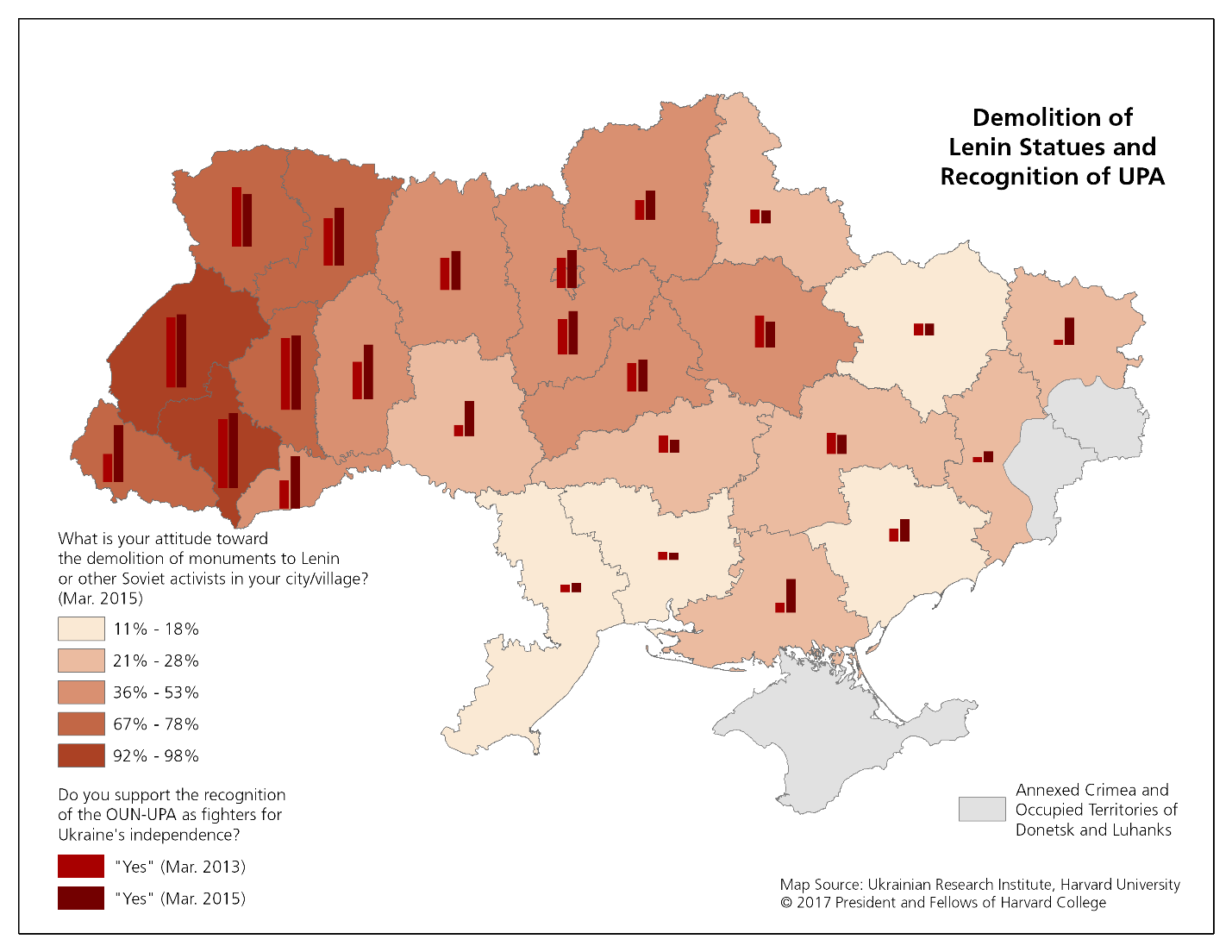Let us now discuss the geographical dimensions of the Leninfall as it occurred between December 2013 and the summer of 2014, keeping in mind the map of the 2010 presidential elections.
Scholars and political activists in Ukraine have made several attempts to map the Leninfall. By far the best-known map, which takes in the period up to the end of February 2014, was produced by the newspaper Den' (The Day). The Den’ map, reproduced below (Map 2), includes the monuments removed in the East—the Crimea and the Donetsk and Luhansk oblasts of Ukraine. The map leaves little doubt that the original Leninfall—the demolition of Lenin statues within the first few months after the fall of the Lenin monument in Kyiv—had a clear regional dimension.[1]
MAP 2
The “eye” of the Leninfall “hurricane” is clearly visible in Ukraine’s Center, making significant inroads into parts of the Southeast. The virtual exclusion of the West from that map has a fairly simple explanation: most of the monuments there were demolished either in the months leading up to Ukrainian independence or in the first years of independence. The exclusion of the East—the Crimea and a good part of the Donbas—is a more complex phenomenon associated with the Russian annexation of the peninsula and the start of the hybrid war in eastern Ukraine. The lack of enthusiasm for demolishing Lenin monuments there is reflected in the results of the 2013 survey and, for non-occupied parts of Ukraine, in the surveys of 2015, as will be discussed below.
What happened in the Center in late 2013 and early 2014, and why did that macro-region emerge as the driving force of the Leninfall? Was a shift in the attitudes of the local population responsible for that change?
Our data from the March 2013 survey along with the research done by scholars in Ukraine suggest that even before the start of the EuroMaidan, support for retaining Lenin monuments in the Center was lukewarm at best. Kyiv oblast, where attitudes more or less reflected those of the Center in general, had 23 percent of respondents wishing to keep such monuments in their towns and villages. The strongest support for the status quo was registered in Poltava oblast, where 34 percent of respondents favored monuments to Lenin in their settlements. These figures set the Center apart from both the West and the Southeast, its immediate regional neighbors. Ternopil oblast in the West had the lowest level of support in the entire country—no respondents at all—in favor of Lenin monuments. Odesa oblast in the Southeast had the country’s highest level of support, with 51 percent of respondents favoring Lenin statues.[2]
That was before the start of the Leninfall. The EuroMaidan, the Revolution of Dignity, and the outbreak of warfare in the East produced a major shift in the historical attitudes of the Center, sharply reducing enthusiasm for Lenin. In Kyiv oblast, support for Lenin monuments fell from 23 percent to 16 percent, while in Poltava it dropped from 34 percent to 10 percent, turning one of the most pro-Lenin regions in the Center into one of its most anti-Leninist.
MAP 3
Map 3 uses shades of color to show the level of support for the demolition of Lenin monuments in March 2015 (the more intense the color, the stronger the desire to get rid of Lenin) In the city of Kyiv there was a majority (53 percent) in favor of demolition, while Kyiv oblast was on par with Poltava oblast: in both cases, 42-43 percent of respondents favored demolition. Once again, the Center stood apart from the Southeast, where support for demolition did not exceed 28 percent of those surveyed, with the lowest level of support (11 percent) registered in Kharkiv oblast. An important aspect of the Leninfall story that emerges clearly from Map 3 is that by March 2015, in terms of desire to rid itself of Lenin monuments, the Center had effectively joined the West to create a joint “Lenin-free” space in Ukraine.
For all its drama, the iconoclastic demolition captured by television cameras in Kyiv and elsewhere was not a sudden rupture in the Center’s narrative of memory but the culmination of a process that had begun earlier. In the course of the 1990s, close to 2,000 Lenin monuments had been demolished in the western regions of Galicia and Volhynia. The process continued into the next decade, spilling over into the Center. In those two macro-regions more than 1,200 statues were removed in the 2000s. Compared to those figures, the Leninfall, which accounted for about 550 statues, was a rather modest development.[3]
The 2013 and 2015 surveys, the first taken before the EuroMaidan, the second afterwards, allow one to suggest that the Center has joined the West in more than the rejection of Lenin and communism. Obscured by the drama of the demolition was the culmination of a process whereby, in the minds of the population at large, Soviet-era mythology was replaced with elements of the Ukrainian national narrative, which represented Ukraine as a major, if not the principal, victim of the Soviet regime. Since the Orange Revolution of 2004, that narrative has come to include the interpretation of the Holodomor, or the Great Ukrainian Famine of 1932–33, as an act of genocide perpetrated by the communist regime in Moscow against the Ukrainian people. Although the Ukrainian parliament voted in 2006 to recognize the Holodomor as an act of genocide, the issue soon became contested, as Russia mounted an international campaign against the genocide interpretation of the Famine, while President Yanukovych, elected in 2010, dropped the reference to genocide from his official pronouncements.[4]
President Yanukovych’s change of rhetoric does not appear to have had much impact on attitudes toward the Holodomor in the Center, where, as shown on Map 4 below, the majority continued to regard it as an act of genocide. That map shows the percentage of respondents who rejected the interpretation of the Holodomor as genocide in March 2013, March 2015 and December 2015. The level of denial is shown by columns, while the color map in the background indicates levels of support for the demolition of Lenin monuments in March 2015.
MAP 4
As may be assumed on the basis of this map, as early as March 2013 the Center was forming a common memory space with the West when it comes to the popular attitude toward the Holodomor and, by extension, toward the overall record of the communist regime. This trend gained new impetus with the EuroMaidan, with a further decline of naysayers in March 2015. The adoption of the decommunization laws in April of that year produced a slight rise in the numbers of naysayers in the Center and even in some parts of the West but did not change the overall picture: the West and Center stood together in recognizing the Holodomor as an act of genocide. The number of skeptics was already low in March 2013. In Chernihiv oblast, for example, they declined from 15 percent in March 2013 to 4 percent in March 2015 and a slight rise of that number to 7 percent in December of that year did not change the overall picture.
That interpretation of the Holodomor set the West and Center apart from the Southeast, where in December 2015 the naysayers, while not constituting a majority, still showed significant strength. Their percentage was highest in the Ukraine-controlled areas of Donetsk oblast, reaching 30 percent of respondents. The decommunization laws revealed the difference between the attitude toward the Holodomor in the combined Center-West and Southeast, reducing the number of naysayers in the Southeast and slightly increasing it in the Center and West. The two memory spaces were clearly marching to different drums.
The common memory space of the West and Center was formed not only by the rejection of the communist regime and the condemnation of its crimes but also by the joint adoption of elements of the new nation-based historical discourse. The significant element here is the popular attitude toward the fighters of the UPA—the World War II-era nationalist-led Ukrainian Insurgent Army, which has been a hot-button issue in Ukrainian politics since 2004. The UPA, whose soldiers are as much praised for their resistance to the communist regime as they are criticized or even vilified for participation in the ethnic cleansing of Poles, fought in the Western regions of Galicia and Volhynia and has been part of the living memory of the local population. Those living in the West saw the UPA condemned under the Soviet regime and celebrated during the years of independence. The Center, which had no direct exposure to living memory of the UPA, has been slow to accept the relevant historical mythology as part of its own narrative.
This is one of the features of memory politics in Ukraine reflected by Map 5. Its shades of color show levels of support for the demolition of Lenin monuments, while its columns show varying degrees of support for the proposed official recognition of UPA soldiers as fighters for Ukrainian independence. Ternopil oblast, the West’s leader in terms of anti-Leninist sentiment, also led in acceptance of the pro-UPA narrative. Support for the recognition of UPA soldiers as fighters for Ukrainian independence increased there from 94 percent in 2013 to an overwhelming 98 percent in 2015.
MAP 5
Map 5 also shows that in enthusiasm for the UPA, the Center has been catching up with the West, and the EuroMaidan produced a boost in that regard. In March 2015 more respondents were in favor of the UPA in the Khmelnytsky region in the Center than in Volyn (Volhynia) oblast in the West: 72 percent vs. 69 percent. Support for UPA recognition increased most dramatically in Transcarpathia, where it grew from 37 percent to 75 percent of respondents. In Kyiv oblast the rise in support was less dramatic but increased from 47 percent to a majority of 57 percent. While support for the UPA had been negligible in the Southeast before the EuroMaidan, it grew in that region as well, especially in oblasts affected by the Russo-Ukrainian war: in Luhansk from 7 percent to 35 percent and in Kherson from 13 percent to 44 percent of respondents—still quite low in comparison to the Center.
Thus the Leninfall is best understood as the culmination of a relatively long process fueled by two parallel developments—the condemnation of communist crimes and the acceptance of a nationalist alternative to the communist historical narrative. Both developments began in the West in the 1990s and made inroads into the Center in the 2000s. The creation of a common West-Central memory space was sealed in symbolic terms by the public toppling of the Lenin statues, but it had begun to develop in the decades following Ukrainian independence and the Orange Revolution of 2004.
The maps reproduced above indicate that the memory shift that brought the West and Center together also highlighted differences in historical attitudes between the Center and the Southeast. Under the influence of the EuroMaidan and, especially, the Russo-Ukrainian war, the Southeast began to move closer to the Center in condemning the crimes of the communist regime but in many ways remained outside the new common West-Central memory space. Few things better demonstrated the memory gap between the West and Center on the one hand and the Southeast on the other than the hundreds of Lenin monuments still standing in prominent public spaces in the Southeast after the triumph of the Leninfall in the Center in 2013–14. But there the change was coming as well.



